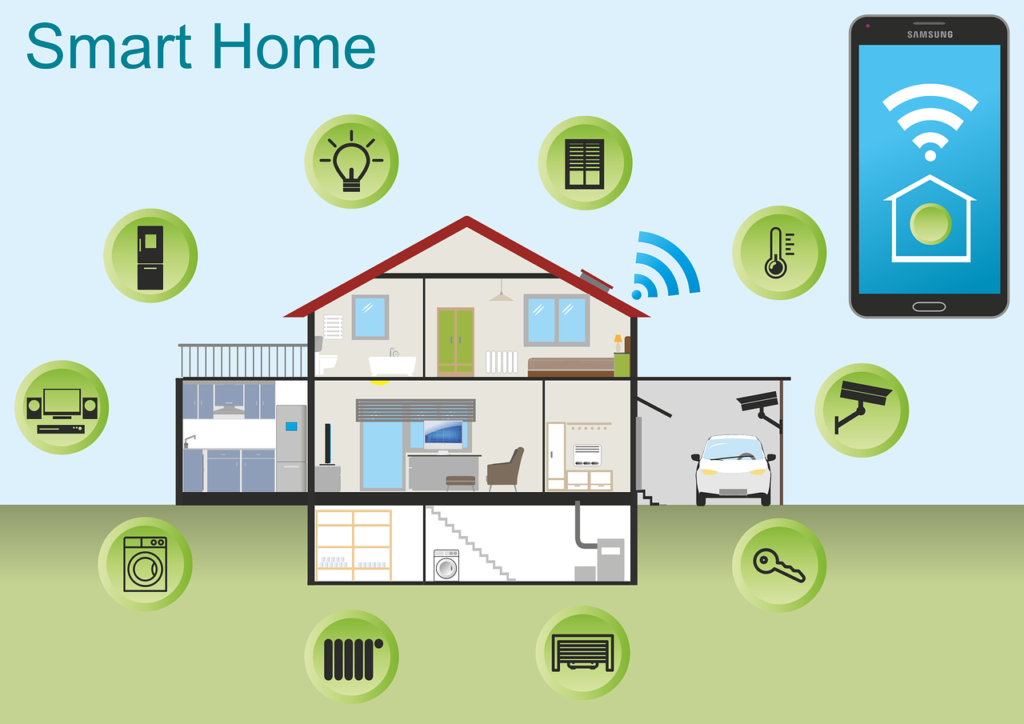Are you ready to transform your home into a futuristic haven? Look no further than the essential components of a smart home setup. From intelligent thermostats to voice-controlled lighting, these innovative technologies are designed to make your life easier and more convenient. With a plethora of options available, it may seem daunting to navigate the world of smart home devices. But fear not, as we have curated a list of must-have components that will revolutionize your home and bring it into the 21st century. Get ready to embrace the power of automation and create a truly smart home experience.

1. Smart Hub
A smart hub is the central control unit of a smart home setup. It acts as a communication hub, allowing you to connect and control various smart devices within your home. One of the key benefits of having a smart hub is the convenience it offers. With a smart hub, you can control multiple devices simultaneously using a single interface, usually a mobile app or a voice command. This eliminates the need to juggle between different apps or remotes to control individual devices.
1.1 Benefits of a Smart Hub
Having a smart hub brings numerous benefits to your home automation system. Firstly, it creates a seamless and integrated experience by connecting all your smart devices and allowing them to work together. This means that you can create routines and scenarios where multiple devices perform actions automatically, for example, when you leave the house, the lights turn off, the thermostat adjusts to an energy-saving mode, and the security system activates.
Secondly, a smart hub enhances the accessibility and convenience of controlling your smart home. With a single app or voice command, you can control various devices from anywhere, even if you are not physically present in your home. This means that you can turn on the lights, adjust the temperature, or even lock the doors remotely.
Lastly, a smart hub offers compatibility with a wide range of smart devices and brands, allowing you to choose the devices that best suit your needs and preferences. It eliminates the worry of compatibility issues and ensures that your devices can seamlessly communicate with each other.
1.2 Popular Smart Hub Options
There are several popular smart hub options available on the market. Some of the leading brands include:
Amazon Echo: The Amazon Echo, powered by Alexa, is a popular choice for many homeowners. It not only functions as a smart hub but also integrates with other Amazon products, such as smart speakers and displays, to provide a comprehensive smart home experience.
Google Nest Hub: The Google Nest Hub, powered by Google Assistant, is another widely used smart hub. It offers a range of features, including voice control, video streaming, and integration with other Google services.
Samsung SmartThings: Samsung SmartThings is a versatile smart hub that supports a wide range of devices. It provides a user-friendly interface and allows you to control and automate multiple aspects of your home.
2. Voice Assistant
A voice assistant is a virtual assistant that responds to voice commands and performs various tasks. In the context of a smart home setup, a voice assistant can be integrated with a smart hub to control and manage different devices using voice commands.
2.1 Voice Assistant Features
Voice assistants offer a range of features that enhance the functionality and convenience of your smart home. Some common features include:
Voice Control: The primary function of a voice assistant is to respond to voice commands. This allows you to control various smart devices simply by speaking to the assistant. For example, you can ask the voice assistant to turn on the lights, play music, or adjust the thermostat.
Smart Home Integration: Voice assistants can be integrated with your smart hub, allowing you to control all connected devices with voice commands. This integration enables a hands-free and seamless smart home experience.
Information and Entertainment: Voice assistants can provide you with real-time information, such as weather updates, news headlines, and sports scores. They can also play music, set timers, and answer questions on a variety of topics.
2.2 Leading Voice Assistant Brands
There are several leading voice assistant brands available in the market. These brands offer voice assistants with different features and capabilities. Some of the popular voice assistant brands include:
Amazon Alexa: Amazon Alexa is known for its wide range of skills and compatibility with numerous smart devices. It can be accessed through Amazon Echo devices and other compatible smart speakers.
Google Assistant: Google Assistant is integrated into various devices, including Google Nest Hub, Android smartphones, and Google Home speakers. It offers a powerful and intuitive voice control experience.
Apple Siri: Siri is the voice assistant developed by Apple and is primarily used on Apple devices like iPhones, iPads, and Macs. It provides seamless integration with other Apple services and devices.
3. Smart Lighting
Smart lighting is an essential component of a smart home setup. It enables you to control and automate your home’s lighting system using smart devices and technology. Smart lighting offers several advantages over traditional lighting systems.
3.1 Advantages of Smart Lighting
One of the main advantages of smart lighting is increased energy efficiency. Smart lighting systems can be programmed to automatically turn off lights when they are not in use or adjust the brightness level based on natural light conditions. This helps reduce energy consumption and lowers electricity bills.
Another advantage of smart lighting is enhanced convenience and control. With a smart lighting system, you can easily turn on or off the lights, dim or brighten them, and even change the color of the lights using a mobile app or voice commands. This level of control allows you to create personalized lighting scenes for different activities and moods.
Smart lighting also improves home security by offering features such as scheduled lighting, where the lights can be programmed to turn on and off at specific times, creating the illusion of occupancy even when you are away from home. Additionally, smart lighting can be integrated with other security devices, such as motion sensors or door/window sensors, to enhance home security.
3.2 Types of Smart Lighting
There are various types of smart lighting technologies and products available in the market. Some popular options include:
Smart Bulbs: Smart bulbs are LED bulbs that can be controlled wirelessly using a mobile app or voice commands. These bulbs can often change colors and adjust brightness levels. They can be easily installed in existing light fixtures and are a cost-effective way to upgrade to smart lighting.
Smart Light Strips: Smart light strips are flexible LED strips that can be attached to various surfaces. They offer versatile lighting options and are often used for accent lighting or decorative purposes. Smart light strips can be cut to size and controlled individually or as a group.
Smart Light Switches: Smart light switches replace traditional light switches and can be controlled remotely using a mobile app or voice commands. These switches can be installed in place of existing switches and are an ideal choice for homes without smart bulbs.
4. Security and Surveillance
Security and surveillance are crucial aspects of a smart home setup. Smart security devices can monitor your home’s safety, provide real-time alerts, and enhance overall security.
4.1 Importance of Smart Security
Smart security is essential for protecting your home and loved ones. By implementing smart security devices, you can deter potential intruders, monitor activities in and around your home, and receive instant notifications in case of any security breaches. Smart security systems offer peace of mind, knowing that you have an extra layer of protection for your home, even when you are not present.
4.2 Types of Smart Security and Surveillance Devices
There is a wide range of smart security and surveillance devices available to bolster home security. Some of the most common ones include:
Smart Cameras: Smart cameras, also known as surveillance cameras or security cameras, are equipped with advanced features such as high-definition video recording, night vision, and motion detection. These cameras can be installed indoors or outdoors to monitor your property. Many smart cameras also offer live streaming and recording capabilities, allowing you to check on your home remotely.
Smart Doorbells: Smart doorbells, such as the popular Ring Video Doorbell, provide an additional layer of security for your front door. These doorbells are equipped with cameras and motion sensors, allowing you to see and communicate with visitors from your smartphone, even when you are not at home.
Smart Locks: Smart locks replace traditional door locks and offer enhanced security features. They can be controlled using a mobile app or voice commands, allowing you to lock and unlock your doors remotely. Smart locks also provide features such as temporary access codes and activity logs, giving you full control and visibility over who enters your home.

5. Smart Thermostat
A smart thermostat is a device that allows you to remotely control and manage your home’s heating and cooling system. It offers numerous benefits, ranging from improved energy efficiency to enhanced comfort.
5.1 Energy Efficiency and Comfort
One of the key advantages of a smart thermostat is its ability to optimize energy usage. With a smart thermostat, you can set schedules or create customized heating and cooling profiles based on your daily routine. This means that you can automatically adjust the temperature when you are away from home or asleep, reducing unnecessary energy consumption and saving on utility bills.
Smart thermostats also provide advanced features such as learning algorithms and motion sensors, which help them understand and adapt to your preferences. This ensures that your home remains at a comfortable temperature without manual adjustments.
5.2 Prominent Smart Thermostat Brands
Several brands offer smart thermostats with different features and functionalities. Here are a few notable brands in the market:
Nest: Nest, now a part of Google, offers a range of smart thermostats known for their sleek design and advanced learning capabilities. Nest thermostats can learn your heating and cooling preferences over time and automatically adjust to provide optimal comfort and energy efficiency.
Ecobee: Ecobee smart thermostats are highly regarded for their remote sensors, which allow you to monitor and adjust the temperature in multiple rooms. These thermostats also offer integration with popular voice assistants, such as Amazon Alexa and Google Assistant.
Honeywell: Honeywell is a well-established brand in the thermostat market. Their smart thermostats offer features like geofencing, which can automatically adjust the temperature based on the location of your smartphone, ensuring comfort and energy savings.
6. Smart Appliances
Smart appliances are household devices that are equipped with internet connectivity and advanced features. These appliances can be controlled and monitored remotely, offering convenience and efficiency.
6.1 Convenience and Efficiency
Smart appliances bring convenience to your daily household tasks. With smart appliances, you can control and monitor their functions remotely, saving you time and effort. For example, you can preheat your oven while you are on your way home, or you can start a load of laundry from your smartphone.
In addition to convenience, smart appliances also offer increased energy efficiency. Many smart appliances have energy-saving modes and features that help reduce your energy consumption. For instance, a smart dishwasher can optimize water usage based on the load size and program settings, resulting in lower water and electricity bills.
6.2 Examples of Smart Appliances
There is a wide variety of smart appliances available to suit different needs and preferences. Some popular examples include:
Smart Refrigerators: Smart refrigerators come with features like touchscreen displays, built-in cameras, and connectivity to online recipes and grocery delivery services. These refrigerators provide you with real-time information about the contents of your fridge, track expiration dates, and even suggest recipes based on the available ingredients.
Smart Washers and Dryers: Smart washers and dryers offer features such as remote control, customizable wash cycles, and notifications when a cycle is complete. Some models can even detect the type of clothes and adjust settings accordingly, ensuring optimum cleaning and drying performance.
Smart Vacuum Cleaners: Smart vacuum cleaners, also known as robot vacuums, can be programmed to clean your floors automatically. These devices use advanced sensors and mapping technology to navigate your home and ensure thorough cleaning. Some models can also be controlled using a mobile app or voice commands.

7. Smart Entertainment
Smart entertainment devices enhance your home entertainment experience by providing seamless connectivity, access to media content, and interactive features.
7.1 Enhanced Home Entertainment Experience
Smart entertainment devices offer various features that enhance your overall entertainment experience. These features include:
Media Streaming: Smart TVs and streaming devices allow you to stream your favorite movies, TV shows, and music from popular streaming services, such as Netflix, Hulu, and Spotify. With a smart TV or a streaming device like Apple TV or Roku, you can access a wide range of content from the comfort of your couch.
Voice Control: Many smart entertainment devices support voice control, allowing you to search for content, control playback, and adjust settings using voice commands. This hands-free control enhances convenience and interactivity.
Multi-Room Audio: Smart speakers and audio systems can be connected throughout your home, allowing you to play synchronized music in different rooms or have different audio streams in each room. This creates a immersive audio experience and enhances the ambiance of your home.
7.2 Smart Entertainment Devices
There are numerous smart entertainment devices available on the market. Here are a few examples:
Smart TVs: Smart TVs are equipped with built-in internet connectivity and pre-installed apps, allowing you to stream media content directly on the TV. They often support voice control and offer features like screen mirroring and integration with other smart devices.
Smart Speakers: Smart speakers, such as Amazon Echo or Google Nest speakers, provide voice-controlled access to music streaming services, podcasts, and audiobooks. They can also be integrated with other smart devices to create a seamless and interconnected smart home ecosystem.
Gaming Consoles: Gaming consoles, like the PlayStation or Xbox, offer not only gaming capabilities but also serve as media hubs. These consoles allow you to stream content, access online services, and control other smart devices, providing a versatile entertainment experience.
8. Smart Sensors
Smart sensors play a crucial role in a smart home setup by detecting and monitoring changes in the environment. These sensors provide valuable data that can be used to automate various functions and enhance home security.
8.1 Importance of Smart Sensors
Smart sensors are essential for creating a responsive and intelligent home automation system. They enable your smart home to detect changes in temperature, light, motion, and even air quality. This information is used to trigger actions, such as adjusting the thermostat, turning on or off lights, or sending notifications to your smartphone.
Smart sensors are also crucial for home security. They can detect unauthorized entry, motion in specific areas, or even leaks and floods, allowing you to take immediate action or receive real-time alerts. By integrating smart sensors with your home automation system, you can have a comprehensive view of your home’s environment and ensure that it remains safe and comfortable.
8.2 Different Types of Smart Sensors
There are various types of smart sensors available, each designed to detect and monitor different aspects of your home. Some common types of smart sensors include:
Motion Sensors: Motion sensors detect movement in specific areas and can trigger actions, such as turning on lights or activating security cameras. These sensors are often used for both security and automation purposes.
Door/Window Sensors: Door/window sensors are typically placed on doors and windows to detect if they are opened or closed. They are an important component of a smart security system and can trigger alarms or send notifications when unauthorized access is detected.
Temperature Sensors: Temperature sensors monitor the temperature in different areas of your home. They can be used to adjust the thermostat automatically or to provide you with real-time temperature data.
Water Leak Sensors: Water leak sensors are designed to detect leaks or floods. These sensors are often placed in areas prone to water damage, such as basements, bathrooms, or near appliances like washing machines and dishwashers. When a leak is detected, the sensor can send an alert to your smartphone, allowing you to take immediate action and prevent further damage.

9. Home Automation System
A home automation system is a centralized control system that connects and controls various smart devices in your home. It allows you to automate and manage different aspects of your home, providing convenience, energy efficiency, and control.
9.1 Centralized Control
One of the primary benefits of a home automation system is centralized control. With a home automation system, you can control and manage multiple smart devices from a single interface, such as a mobile app or a voice assistant. This eliminates the need to use different apps or remotes for each device, simplifying the overall user experience. With just a few taps or voice commands, you can adjust the lighting, temperature, security system, and entertainment devices in your home.
9.2 Features of a Home Automation System
A home automation system offers various features that enhance the functionality and convenience of your smart home. Some common features include:
Routines and Scenes: Home automation systems allow you to create routines and scenes that automate multiple actions with a single command. For example, you can create a “Good Morning” routine that turns on the lights, adjusts the thermostat, and plays your favorite music, all with a single voice command.
Integration with Voice Assistants: Many home automation systems integrate with popular voice assistants, such as Amazon Alexa or Google Assistant. This allows you to control your smart home using voice commands and adds another layer of convenience to your daily routine.
Scheduling and Automation: Home automation systems enable you to schedule or automate different actions based on specific conditions or timings. For example, you can schedule your lights to turn on at sunset or automate your security system to arm itself when no motion is detected.
Remote Access: Most home automation systems offer remote access, allowing you to control and monitor your smart home from anywhere using a smartphone or tablet. This means that you can adjust settings, receive notifications, or even check security camera feeds while you are away from home.
10. Smart Locks
Smart locks are an important component of a smart home setup as they provide enhanced security and convenience for your home’s entry points.
10.1 Security and Convenience
Smart locks offer improved security over traditional door locks. Unlike traditional locks that require physical keys, smart locks can be locked or unlocked using a mobile app, a keypad, or even voice commands. This eliminates the need for physical keys and the risk of lost or stolen keys. Smart locks also offer features such as temporary access codes, which can be shared with family members, friends, or service providers for specific durations, ensuring controlled access to your home.
In terms of convenience, smart locks allow you to remotely lock or unlock your doors using a smartphone. Forgot to lock the door before leaving the house? No problem, just open the app and lock it remotely. Smart locks also offer integration with other smart devices, such as doorbells or cameras, allowing you to see who is at the door and grant access remotely.
10.2 Notable Smart Lock Brands
Several notable brands offer smart locks with different features and capabilities. Here are a few popular options:
August: August smart locks are known for their easy installation and seamless integration with other smart devices. These locks offer features such as auto-locking, remote access, and compatibility with popular voice assistants.
Schlage: Schlage smart locks are known for their robust security features and durability. They offer features such as built-in alarm systems and compatibility with a variety of smart home platforms.
Yale: Yale smart locks provide a wide range of options, including keyless entry, touchscreen interfaces, and remote access. These locks offer flexibility and functionality, allowing you to choose the features that best suit your needs.
In conclusion, a smart home setup consists of various essential components that work together to enhance convenience, energy efficiency, security, and entertainment. From smart hubs and voice assistants to smart lighting, security devices, thermostats, appliances, entertainment devices, sensors, and locks, each component adds value to your smart home experience. By embracing these technologies, you can transform your home into a modern, intelligent, and connected living space that simplifies your day-to-day life and offers a higher level of comfort and control.











